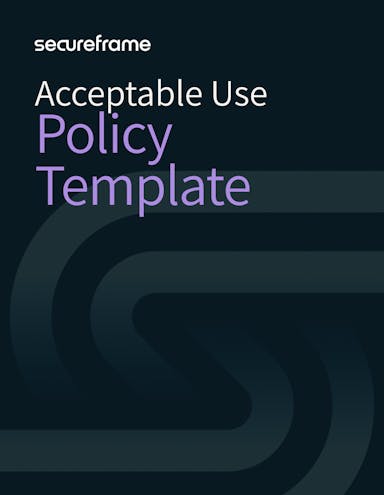
How to Create an Acceptable Use Policy (AUP) That Protects Your Business [+ Template]
Emily Bonnie
Senior Content Marketing Manager
Rob Gutierrez
Senior Cybersecurity and Compliance Manager, CISA, CCSK, CMMC RP
Human error is the leading cause of cybersecurity incidents. According to recent research by Stanford University, 88% of data breaches are caused by human error. Even the most advanced firewalls, intrusion detection systems, and endpoint protections can’t stop a breach if someone clicks on a phishing link, uses a weak password, or stores confidential data in an unapproved app.
Imagine you’re designing a security system for your home. You could have every protection imaginable: alarm systems, security cameras, motion sensors, etc. But if your housemates don’t know that they need to lock the front door behind them, those protective measures won’t be very effective.
This is why an Acceptable Use Policy (AUP) is so important. An AUP establishes guidelines and expectations for how personnel should use your information technologies in a way that keeps both the organization and employees safe. With clear expectations, employees will know how to protect your confidential information from unauthorized access.
Step-by-step guide: How to write an Acceptable Use Policy (AUP)
A well-structured AUP provides clear guidelines for users and helps protect your organization's information systems from misuse. Let's walk through a step-by-step guide on how to create one.
Step 1. Establish scope
The first step in writing an AUP is to define the scope of your policy clearly. Articulate who the policy applies to (employees, contractors, temporary staff, etc.), the technology and data it covers, and under what circumstances it applies. Be clear and precise, and make sure to cover all areas of your organization and every type of user.
Step 2. Consult stakeholders
Meet with any other stakeholders, including members of your IT team, legal counsel, security, compliance, and HR personnel, to help draft or review your AUP. This will ensure your AUP is comprehensive and compatible with your organization’s information security needs.
Step 3. Define acceptable and unacceptable use
In the heart of your AUP, outline what constitutes acceptable and unacceptable use of your company’s IT resources, including computer systems and corporate networks. Remember, the purpose here is not to limit creativity or productivity but to prevent misuse or abuse. You’ll want to include specifics about:
- Email messages and electronic communications
- Social media usage
- Software or app downloads
- Copyright and intellectual property
- Confidential data handling
- Use of personal or mobile devices on company networks
- Use of company devices or networks for personal use, such as accessing personal email or social media accounts
- Removable media
Step 4. Set security expectations
Given the ever-increasing number of cyber threats, your AUP should include a section dedicated to security expectations. Address issues like:
- Strong password requirements
- How to handle suspicious emails, messages, or files
- Requirements for regularly updating and patching software
- Rules around using company devices on public Wi-Fi networks
- Bring your own device (BYOD) guidelines
Step 5. Consider legal and compliance requirements
Your AUP should align with applicable laws, industry regulations, and compliance requirements. If you're unsure, it's wise to consult with a compliance expert and/or legal professional. Some legal elements you might need to consider are intellectual property rights and data privacy laws such as GDPR.
Step 6. Explain the consequences of non-compliance
Your AUP should clearly spell out the potential repercussions if the policy is violated. Disciplinary actions might range from reprimands or loss of certain privileges to employment termination or even legal action. The key here is ensuring that end users understand what’s at stake.
Step 7. Review, update, and communicate regularly
An AUP isn't a document that you write once and set on a shelf. As your organization, technology, and the compliance landscape evolve, so should your policy. Establish a process for regular reviews to ensure your AUP stays relevant and effective.

Acceptable Use Policy Template
Set clear guidelines for responsible use of company technology and reduce the risk of security incidents caused by human error with this downloadable Acceptable Use Policy template.
Tips for adopting an Acceptable Use Policy within your organization
Just writing an AUP isn’t enough to protect your computer networks and information resources. Implementing, communicating, and enforcing compliance with the policy is crucial. Here are some key tips for successfully adopting an AUP within your organization:
Write the policy with your specific audience in mind
Don’t fill your policy with technical jargon. Use clear and simple language, break up large blocks of text, and use headers to separate key sections. Make your policy relatable and straightforward for your personnel.
Explain why and how the AUP was developed to foster employee buy-in
Knowing that the policy was developed to protect their work devices from malware, improve data security, and maintain compliance — and that employees across the organization collaborated to write a fair and accurate AUP — can help employees understand its importance and follow its guidance.
Verify that employees fully understand the policy and what it means for them
A short, informal quiz or True/False question can ensure staff have read and understand the policy and what it means for their daily work practices. It’s also a good idea to include contact information for the policy owner and encourage employees to ask questions or offer feedback.
Keep all of your policies in a single, easily accessible place
If employees only see your information security policies when they first onboard, they’re not likely to remember them well enough to actually follow them in their daily work. Maintain all of your policies (and other security and compliance documents, processes, and evidence) in a compliance management system to simplify policy review and acceptance, employee onboarding, and compliance processes. Or include a link to a folder where all of your policies can be accessed in your regular security awareness training sessions or all-hands meeting slides.
Put policies into practice with Secureframe
Writing an Acceptable Use Policy is only the first step. The real challenge is making sure people understand it, apply it consistently, and keep up with changes as your business and technology evolve. Without ongoing training, updates, and enforcement, even the best-written policy risks being ignored.
Secureframe’s compliance automation platform makes it simple to manage policies, track acknowledgment, and monitor compliance continuously. Instead of treating your AUP as a static document, you can turn it into a living part of your security program to reduce risk, meet regulatory requirements, and keep your business safe. Learn more about Secureframe by requesting a demo with a product expert.
Use trust to accelerate growth
FAQs
What should an Acceptable Use Policy include?
An AUP should cover the scope of users and systems, define acceptable and unacceptable use, set security expectations, explain compliance requirements, and outline consequences for violations.
Who needs an Acceptable Use Policy?
Every organization, regardless of size or industry, benefits from having an AUP. If your employees use company devices, networks, or access sensitive information, you need one.
How often should an Acceptable Use Policy be updated?
At least once a year, or whenever there are major changes to your IT environment, compliance obligations, or security risks.
What’s the difference between an AUP and a security policy?
AUPs focus specifically on how employees use technology resources, while a broader security policy covers your organization’s overall security framework, including risk management, incident response, and physical security.

Emily Bonnie
Senior Content Marketing Manager
Emily Bonnie is a seasoned digital marketing strategist with over ten years of experience creating content that attracts, engages, and converts for leading SaaS companies. At Secureframe, she helps demystify complex governance, risk, and compliance (GRC) topics, turning technical frameworks and regulations into accessible, actionable guidance. Her work aims to empower organizations of all sizes to strengthen their security posture, streamline compliance, and build lasting trust with customers.

Rob Gutierrez
Senior Cybersecurity and Compliance Manager, CISA, CCSK, CMMC RP
Rob Gutierrez is an information security leader with nearly a decade of experience in GRC, IT audit, cybersecurity, FedRAMP, cloud, and supply chain assessments. As a former auditor and security consultant, Rob performed and managed CMMC, FedRAMP, FISMA, and other security and regulatory audits. At Secureframe, he’s helped hundreds of customers achieve compliance with federal and commercial frameworks, including NIST 800-171, NIST 800-53, FedRAMP, CMMC, SOC 2, and ISO 27001.